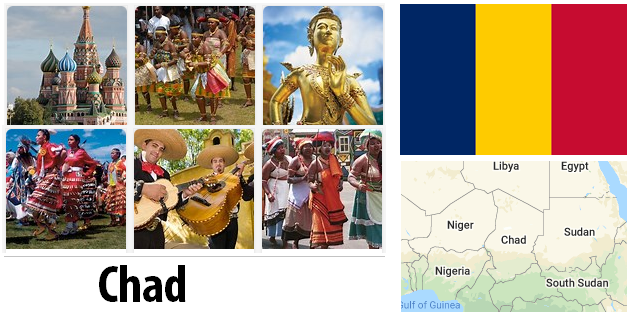Anyone who travels to Chad knows what they are getting into: visitors meet a country that is completely undeveloped for tourism, a country that has been almost brought to its knees by past and current conflicts. In the past they had great ones Natural wonder of Chad among Sahara travelers an almost mythical sound, even experienced visitors to Africa dreamed of the Tibesti Mountains in the north of Chad.
Only a few places in Chad are safe to travel at the moment. The Infrastructure is in a very bad condition, supply shortages for fuel and food must be expected.
There is currently a security notice from the Federal Foreign Office for Chad! It is not clear how the situation is developing in the country, especially before traveling to the border region with Sudan (Darfur) is strongly discouraged. Travel to Chad that is not absolutely necessary (exception: capital N’Djamena) should continue to be postponed. Traveling in the country is associated with considerable risks. The north, east and southeast of the country are particularly at risk. In the Tibesti Mountains there are extensive mine fields that have not been mapped.
Culturally, the groups of the population in Chad can be roughly divided into Arab-Islamic peoples and Black African-animistic ethnic groups. In addition, there are some Christian groups in the south. The population living in the north belong predominantly to Arab culture. They are mainly semi-nomadic tribes that breed cattle. The south of Chad, on the other hand, is mainly settled farmers who work in agriculture.
The north of Chad is dry and largely covered by deserts. Further south there are thorn and dry savannahs before entering the Sahel region. The south of the country, on the other hand, is changeable and receives sufficient rainfall.
Area: 1,284,000 km² (land: 1,259,200 km², water: 24,800 km²), one of the largest countries in Africa.
Population: 10.8 million people (July 2011, COUNTRYAAH.COM). There are almost 200 different peoples in Chad, most of whom speak their own languages or dialects. The north is largely Arab-Islamic, the south, on the other hand, is African-African and Christian. The largest races are the Sara (27.7%), Arabs (12.3%), Mayo-Kebbi (11.5%) and Kanem-Bornou (9%).
In the north of Chad, semi-nomadic cattle breeding is dominant while in the southern part of the country agriculture is predominantly practiced.
Population density: 8.4 people per sq. Km, one of the lowest in Africa.
Population growth: 2.009% per year (2011, CIA).
Capital: N’Djaména (753,000 residents in 2006, 1.4 million in the entire metropolitan area).
Highest point: Emi Koussi, 3,415 m
Lowest point: Djourab Depression, 160 m
Form of government: On 11 August 1960, Chad gained independence from France and declared itself a presidential republic. A new constitution was drawn up in 1996. The National Assembly is made up of 155 MPs who are elected every four years.
Administrative division: 18 regions: Batha, Borkou-Ennedi-Tibesti, Chari-Baguirmi, Guera, Hadjer-Lamis, Kanem, Lac, Logone Occidental, Logone Oriental, Mandoul, Mayo-Kebbi Est, Mayo-Kebbi Ouest, Moyen-Chari, Ouaddai, Salamat, Tandjile, Ville de N’Djamena and Wadi Fira.
Prime Minister: Prime Minister Djimrangar Dadnadji, since January 21, 2013
Head of state: President Idriss Déby, since December 2, 1990
Language: The official languages in Chad are French (only spoken by the educated upper class) and Arabic (mother tongue for 26% of the population). The Sara language is widely spoken in the south. There are also more than 120 regional languages and dialects, many speak multiple languages.
Religion: Muslims (53.1%, especially Sunnis), Catholics (20.1%), Protestants (14.2%), followers of traditional African religions (7.3%), others (0.5%), unknown (1.7%), atheists (3.1%) (1993 census).
Local time: CET
There is no daylight saving time change in Chad.
The time difference to Central Europe is 0 h in winter and -1 h in summer
Telephone prefix: 00235 or +235
Internet identifier:.td
Mains voltage: 220/380 V, 50 Hz, but the power supply (especially in rural regions) is not always guaranteed.
Geography
The Chad shares borders with the following countries: in the north with Libya, in the west with Niger, Cameroon and Nigeria to the south with the Central African Republic and in East Sudan.
Chad covers the east of the Chad Basin (a low-lying plain that gradually rises to the east and north) and most of Lake Chad. The Chad basin is surrounded by mountains and the Central African plateau, in the northeast of the basin the Ennedi highlands rise to 1,450 m. In the north of the country in the volcanic mountains Tibesti with 3,415 m (Emi Kussa) is the highest elevation of the Sahara.
Here you can find a detailed topographic map of Chad.
About half of the country’s area (the north and northeast) is occupied by the Sahara. In the south the desert merges into the Sahel zone with thorny shrub and dry savannah, on rivers you will find flood savannahs and gallery forests, in the extreme south also dry forests.
Agriculture is practically only possible in the southern part of the country. The focus of the field crops is on the staple food millet and on cotton for export. The agricultural centers are particularly located on Lake Chad and in the flood regions of the Shari and Logone rivers.
Both the Shari and the Logone flow into Lake Chad.
The area of Lake Chad changes enormously depending on the water level and is between 25,000 and 10,000 square kilometers. The most important rivers in the country (Shari, Logone and Bahr Salamat) only carry water in the rainy seasons.
The armed conflict with Libya over the Aozou Strip in northern Chad was decided in 1994 by the International Court of Justice in The Hague for Chad.
Chad population
This map of Chad’s population distribution was created by the Worldmapper team. Densely populated areas appear bloated, the area of sparsely populated areas is reduced. The shape of the grid has been preserved; an underlying map with the original geographical extent helps interpret the map. The distorted map should help to present abstract statistical information clearly.




